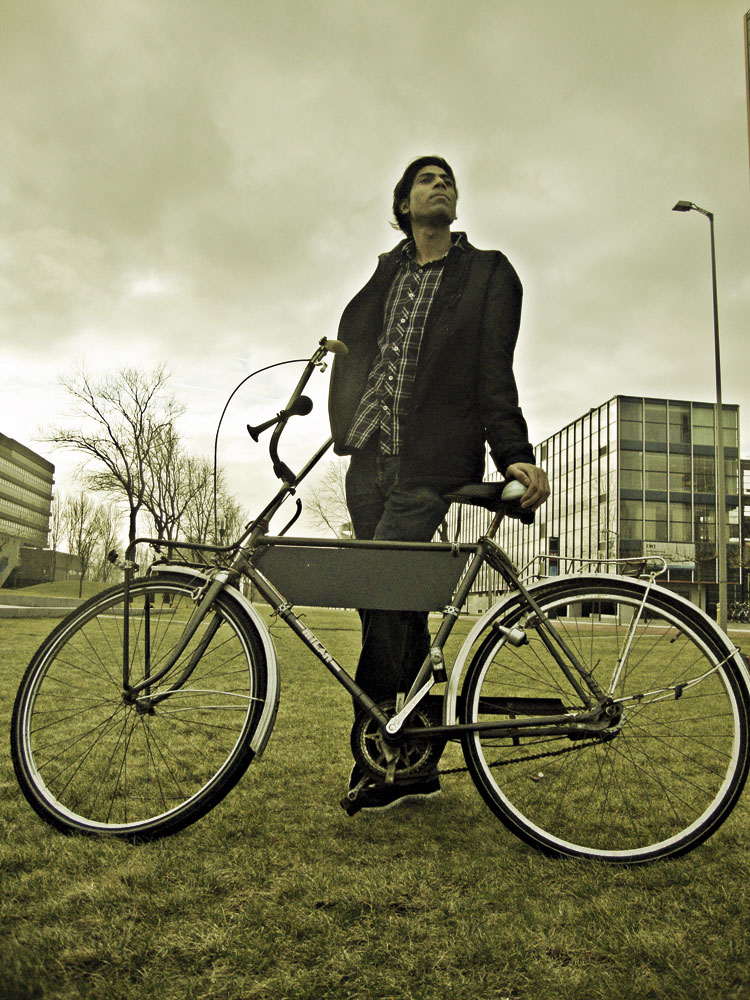Name: Siddharth Ravichandran (MSc Aerospace Engineering, from India)
Brand: Unknown
Price: Gratis
Striking feature: Quaint press-style old horn
Ask Siddharth to talk about his bike and he gushes happily like a kid.
Name: Siddharth Ravichandran (MSc Aerospace Engineering, from India)
Brand: Unknown
Price: Gratis
Striking feature: Quaint press-style old horn
Ask Siddharth to talk about his bike and he gushes happily like a kid.
“One of my proudest possessions in Delft is my unique bike.” He and his friends call it ‘The Harley’. He reminisces about the origin of the name: “On one of the trips to the repair shop long ago, the mechanic christened it the Harley Davidson fiets. I couldn’t have named it better myself.”
So what is special about Harley? “It’s actually a modified bakfiets, or a baker’s bike with the front carrier platform removed. It has high handlebars, a high seat and a lovable rattle. It offers a very comfortable, smooth ride. It has a good set of gears and a reliable retro-pedal system that has proven itself on wet or snowy ground on many occasions. It also has a large carrier on the front and a smaller one on the back, making it ideal for shopping trips. Moreover I was fortunate in acquiring it ‘gratis’ or free from a close acquaintance.”
You realize that you’re talking to an aerospace engineer when Siddharth mentions Harley’s only shortcoming. “Because of the way the rider sits upright on it, it’s not very aerodynamic, which is an important factor in this flat, windy country. And so Harley is unsuitable for long trips. However, I purchased a newer, second-hand bike for 50 euros that is sleek, narrow and perfect for fast, long-distance biking. This bike is a typical ‘Made in Holland’ bike with a great set of gears and narrow wheels built for speed.”
Siddharth admits that biking has influenced him greatly: “To me biking in Holland perfectly characterizes the sustainable, sporty, outdoorsy and do-it-yourself attitude of Dutchmen. Given a choice, I’d ride a bike all my life. I used to ride one to high school back in India, but these days, biking on Indian roads would be a challenge even to the hardiest thrill-seeker in the world.”
Despite having that second, ‘aerodynamic bike’, Siddharth still prefers Harley: “My favorite feature is its quaint press-style old horn, with a sound that reminds me of auto-rickshaws back in India. While I try to use it sparingly, I find it’s a great way to surprise people on the street.”
A loud cracking sound, a set up with a high speed camera that was
almost rampaged, and a total-loss bus – such was the outcome of the
first experiment involving a 13-ton bus crashing into a wooden traffic
barrier at 70 kilometers per hour.
“Right before impact the bus
got a flat tire,” recalls Ingrid de Pauw, of the faculty of Industrial
Design Engineering. “The bus changed direction and crashed into the
barrier at a much greater angle and with a 60% higher energy-impact than
intended.”
It was about a decade ago that De Pauw designed the
barriers and performed the first experiments together with civil
engineers from Delft and a few other interested parties, including a
company called Wijma, which built the barriers and a company called
Ideal & Co.
Now, many experiments and bureaucratic hassles
later, the first stretch of road in the Netherlands – a 1-kilometer long
section of a new provincial road in the town of Heerhugowaard – is
equipped with wooden rather than steel traffic barriers.
“The most
important advantage of a traffic barrier made of FSC-certified hardwood
is that you don’t have any heavy metals seeping into the ground,” says
De Pauw, adding that FSC stands for sustainably grown and cut wood. “The
steel barriers on the other hand are galvanized. Over time the zinc
erodes and ends up polluting the environment.”
Developing a safe
wooden barrier was quite a feat. The researchers had to develop a
completely new way of absorbing energy.
Metal traffic barriers
deform plastically (the metal becomes permanently deformed), thereby
absorbing lots of energy. Wood deforms elastically upon impact and will
ultimately break if the forces are too great. The new barrier therefore
partially consists of steam-bended wooden elements designed for optimal
deformation.
De Pauw thinks that in the long run the wooden
barriers are economically competitive, but for now they can be up to
four times more expensive than metal, depending on the location and
situation: “But wooden barriers do not need to be mended after a minor
collision in which a car only brushes against the barrier, which is in
contrast to the metal barriers. Also with other types of accidents the
wooden guardrail will be less damaged.”

Comments are closed.